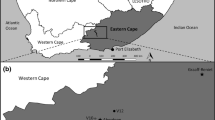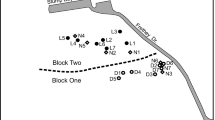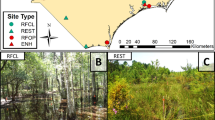Abstract
Although hydroperiod and water chemistry are thought to control temporary wetland macroinvertebrate diversity, their effects are often only detected at the ends of hydrological and water quality gradients. However, canopy cover and other biotic factors dictate solar energy available for producer communities and limit food and shelter for consumers. We surveyed 15 northwest Ohio temporary wetland macroinvertebrate communities and measured pond area, depth, canopy cover, hydroperiod, temperature, water chemistry, leaf litter inputs, algal productivity, vegetation, and land use to evaluate which factors were associated with macroinvertebrate taxon richness, Shannon diversity, and total abundance. Principal components analysis identified four PCA axes explaining 65 % of the variation in our dataset, and subsequent multiple regressions indicated PC2 (canopy-mediated productivity) was associated with 57, 41, and 63 % of the variation in total family richness, Shannon diversity, and predator family richness, respectively. Decreased canopy cover was associated with increased aquatic plant abundance, algal diversity, water temperature, and diurnal dissolved oxygen. These data emphasize the importance of canopy cover as a regulator of diversity and community composition, corroborating other studies finding few associations between invertebrate diversity, hydroperiod, and water chemistry.




Similar content being viewed by others
References
Adler PB, Seabloom EW, Borer ET, Hillebrand H, Hautier Y, Hector A, Harpole WS, O’Halloran LR, Grace JB, Anderson TM, Bakker JD, Biederman LA, Brown CS, Buckley YM, Calabrese LB, Chu CJ, Cleland EE, Collins SL, Cottingham KL, Crawley MJ, Damschen EI, Davies KF, DeCrappeo NM, Fay PA, Firn J, Frater P, Gasarch EI, Gruner DS, Hagenah N, Lambers HRJ, Humphries H, Jin VL, Kay AD, Kirkman KP, Klein JA, Knops JMH, La Pierre KJ, Lambrinos JG, Li W, MacDougall AS, McCulley RL, Melbourne BA, Mitchell CE, Moore JL, Morgan JW, Mortensen B, Orrock JL, Prober SM, Pyke DA, Risch AC, Schuetz M, Smith MD, Stevens CJ, Sullivan LL, Wang G, Wragg PD, Wright JP, Yang LH (2011) Productivity is a poor predictor of plant species richness. Science 333:1750–1753
Allen SE (1989) Chemical analysis of ecological methods. Blackwell Scientific Publications, Oxford
Bailey RC, Norris RH, Reynoldson TB (2001) Taxonomic resolution of benthic macroinvertebrate communities in bioassessments. Journal of the North American Benthological Society 20:280–286
Battle J, Golladay SW (2001) Water quality and macroinvertebrate assemblages in three types of seasonally inundated limesink wetlands in southwest Georgia. Journal of Freshwater Ecology 16:189–207
Batzer D (2013) The seemingly intractable ecological responses of invertebrates in North American wetlands: a review. Wetlands 33:1–15
Batzer DP, Jackson CR, Mosner M (2000) Influences of riparian logging on plants and invertebrates in small, depressional wetlands of Georgia, USA. Hydrobiologia 441:123–132
Batzer DP, Palik BJ, Buech R (2004) Relationships between environmental characteristics and macroinvertebrate communities in seasonal woodland ponds of Minnesota. Journal of the North American Benthological Society 23:50–68
Batzer DP, George BM, Braccia A (2005) Aquatic invertebrate responses to timber harvest in a bottomland hardwood wetland of South Carolina. Forest Science 51:284–291
Binckley CA, Resetarits WJ (2007) Effects of forest canopy on habitat selection in treefrogs and aquatic insects: implications for communities and metacommunities. Oecologia 153:951–958
Binckley CA, Resetarits WJ (2009) Spatial and temporal dynamics of habitat selection across canopy gradients generates patterns of species richness and composition in aquatic beetles. Ecological Entomology 34:457–465
Bischof MM, Hanson MA, Fulton MR, Kolka RK, Sebestyen SD, Butler MG (2013) Invertebrate community patters in seasonal ponds in Minnesota, USA: response to hydrologic and environmental variability. Wetlands 33:245–256
Brewer LG, Vankat JL (2004) Description of vegetation of the Oak Openings of northwestern Ohio at the time of Euro-American settlement. Ohio Journal of Science 104:76–85
Brooks RT (2000) Annual and seasonal variation and the effects of hydroperiod on benthic macroinvertebrates of seasonal forest (“vernal”) ponds in central Massachusetts, USA. Wetlands 20:707–715
Brose U (2003) Island biogeography of temporary wetland carabid beetle communities. J Biogeogr 30:879–888
Campeau S, Murkin HR, Titman RD (1994) Relative importance of algae and emergent plant litter to freshwater marsh invertebrates. Can J Fish Aquat Sci 51:681–692
Carrino-Kyker SR, Smemo KA, Burke DJ (2012) The effects of pH change and NO3 − pulse on microbial community structure and function: a vernal pool microcosm study. FEMS Microbial Ecology 81:660–672
Colburn EA (2004) Vernal pools: natural history and conservation. The McDonald and Woodward Publishing Company, Blacksburg
Colburn E, Weeks S, Reed S (2008) Diversity and ecology of vernal pool invertebrates. In: Calhoun AJK, de Maynadier PG (eds) Science and conservation of vernal pools in northeastern North America. CRC, Boca Raton, pp 105–126
Corbet PS (1999) Dragonflies: behavior and ecology of Odonata. Comstock Publication Associates, Cornell University Press, Ithaca
Culler LE, Smith RD, Lamp WO (2014) Weak relationships between environmental factors and invertebrate communities in constructed wetlands. Wetlands 34:351–361
Cummins KW, Merritt RW (2001) Application of invertebrate functional groups to wetland ecosystem function and biomonitoring. In: Rader RB, Batzer DP, Wissinger SA (eds) Biomonitoring and management of North American freshwater wetlands. Wiley, New York, pp 85–111
Entrekin SA, Golladay SW, Batzer DP (2001) The influence of plant community on chironomid secondary production in two wetland types: cypress-gum swamps and grass-sedge marshes. Archiv fur Hydrobiologie 152:369–394
ESRI (2008) ArcMap 9.3. ESRI, Inc., California
Euliss NH Jr, Wrubleski DA, Mushet DM (1999) Wetlands of the Prairie Pothole Region: invertebrate species composition, ecology, and management. In: Batzer DP, Rader RB, Wissinger SA (eds) Invertebrates in freshwater wetlands of North America: ecology and management. Wiley, New York, pp 471–514
Fairchild GW, Cruz J, Faulds AM, Short AEZ, Matta JF (2003) Microhabitat and landscape influences on aquatic beetle assemblages in a cluster of temporary and permanent ponds. Journal of the North American Benthological Society 22:224–240
Frohn RC (2005) 2003 Land Cover. Ohio Environmental Protection Agency, Columbus, OH. Available via: http://www.dnr.state.oh.us/website/ocm_gis/mapviewer_app/. Accessed 15 Jan 2012
Gabor T, Murkin H, Stainton M, Boughen J, Titman R (1994) Nutrient additions to wetlands in the Interlake region of Manitoba, Canada: effects of a single pulse addition in spring. Hydrobiologia 279:497–510
Halverson M, Skelly D, Kiesecker J, Freidenburg L (2003) Forest mediated light regime linked to amphibian distribution and performance. Oecologia 134:360–364
Hausman CE, Jaeger JF, Rocha OJ (2010) Impacts of the emerald ash borer (ESAB) eradication and tree mortality: potential for a secondary spread of invasive plant species. Biological Invasions 12:2013–2023
Hoverman JT, Davis CJ, Werner EE, Skelly DK, Relyea RA, Yurewick KL (2011) Environmental gradients and the structure of freshwater snail communities. Ecography 34:1049–1058
Lovvorn J, Wollheim W, Hart E (1999) High plains wetlands of southeast Wyoming: salinity, vegetation, and invertebrate communities. In: Batzer DP, Rader RB, Wissinger SA (eds) Invertebrates in freshwater wetlands of North America: ecology and management. Wiley, New York, pp 603–634
Merritt RW, Cummins KW (1996) An introduction to the aquatic insects of North America. Kendall/Hunt, Dubuque
Mitchell JC, Paton PWC, Raithel CJ (2008) The importance of vernal pools to reptiles, birds, and mammals. In: Calhoun AJK, de Maynadier PG (eds) Science and conservation of vernal pools in Northeastern North America. CRC, Boca Raton, pp 169–192
Mitsch WJ, Gosselink JC (2007) Wetlands. Wiley, New York
Nicolet P, Biggs J, Fox G, Hodson MJ, Reynolds C, Whitfield M, Williams P (2004) The wetland plant and macroinvertebrate assemblages of temporary ponds in England and Wales. Biological Conservation 120:261–278
Oertli B, Indermuehle N, Angélibert S, Hinden H, Stoll A (2008) Macroinvertebrate assemblages in 25 high alpine ponds of the Swiss National Park (Cirque of Macun) and relation to environmental variables. Hydrobiologia 597:29–41
Palik B, Batzer DP, Buech R, Nichols D, Cease K, Egeland L, Streblow DE (2001) Seasonal pond characteristics across a chronosequence of adjacent forest ages in northern Minnesota, USA. Wetlands 21:532–542
Pitt AL, Baldwin RF, Lipscomb DJ, Brown BL, Hawley JE, Allard-Keese CM, Leonard PB (2012) The missing wetlands: using local ecological knowledge to find cryptic ecosystems. Biodiversity and Conservation 21:51–63
Prenger JP, Crisman TL (2001) Impact of timber harvest on wetlands: assessment and management. In: Rader RD, Batzer DP, Wissinger SA (eds) Bioassessment and management of North American freshwater wetlands. Wiley, New York, pp 429–449
Quinn GP, Keough MJ (2002) Experimental design and data analysis for biologists. Cambridge University Press, Cambridge
Reins JR, Schwart MS, Mustafa F, Hoback WW (2013) Aquatic macroinvertebrate communities and water quality at buffered and non-buffered wetlands sites on federal waterfowl productions areas in the Rainwater Basin, Nebraska. Wetlands 33:1025–1036
Rubbo MJ, Kiesecker JM (2004) Leaf litter composition and community structure: translating regional species changes into local dynamics. Ecology 85:2519–2525
Ruhí A, Batzer DP (2014) Assessing congruence and surrogacy among wetland macroinvertebrate taxa towards efficiently measuring biodiversity. Wetlands 34:1061–1071
Schiesari L (2006) Pond canopy cover: a resource gradient for anuran larvae. Freshwater Biology 51:412–423
Schriever TA, Cadotte MW, Williams DD (2014) How hydroperiod and species richness affect the balance of resource flows across aquatic-terrestrial habitats. Aquatic Sciences 76:131–143
Semlitsch RD (2003) Amphibian conservation. Smithsonian Institution, Washington, D.C.
Semlitsch RD, Skelly DK (2008) Ecology and conservation of pool breeding amphibians. In: Calhoun AJK, deMaynadier PG (eds) Science and conservation of vernal pools in Northeastern North America. CRC, Boca Raton, pp 127–148
Skelly DK, Werner EE, Cortwright SA (1999) Long-term distributional dynamics of a Michigan amphibian assemblage. Ecology 80:2326–2337
Stewart TW, Downing JA (2008) Macroinvertebrate communities and environmental conditions in recently constructed wetlands. Wetlands 28:141–150
Studinski JM, Grubbs SA (2007) Environmental factors affecting the distribution of aquatic invertebrates in temporary ponds in Mammoth Cave National Park, Kentucky, USA. Hydrobiologia 575:211–220
Tangen BA, Butler MG, Ell MJ (2003) Weak correspondence between macroinvertebrate assemblages and land use in prairie pothole region wetlands, USA. Wetlands 23:104–115
Tarr T, Baber M, Babbitt K (2005) Macroinvertebrate community structure across a wetland hydroperiod gradient in southern New Hampshire, USA. Wetlands Ecology and Management 13:321–334
Urban MC (2004) Disturbance heterogeneity determines freshwater metacommunity structure. Ecology 85:2971–2978
Wallace JB, Eggert SL, Meyer JL, Webster JR (1997) Multiple trophic levels of a forest stream linked to terrestrial litter inputs. Science 277:102–104
Webb KD, Mitsch WJ (2001) Macroinvertebrate diversity and abundance in two experimental wetlands from top-down and bottom-up interpretations. Olentangy River Wetlands Research Park Annual Report, pp 73–80
Werner EE, Glennemeier KS (1999) Influence of forest canopy cover on the breeding pond distributions of several amphibian species. Copeia 1999:1–12
Werner EE, Skelly DK, Relyea RA, Yurewicz KL (2007) Amphibian species richness across environmental gradients. Oikos 116:1697–1712
Williams BK, Rittenhouse TAG, Semlitsch RD (2008) Leaf litter input mediates tadpole performance across forest canopy treatments. Oecologia 155:377–384
Wissinger SA, Whiteman HH, Sparks GB, Rouse GL, Brown WS (1999) Foraging trade-offs along a predator-permanence gradient in subalpine wetlands. Ecology 80:2102–2116
Zar JH (1999) Biostatistical analysis, 4th edn. Prentice Hall, Upper Saddle River
Acknowledgments
This project received field assistance from D. Bonner and K. Michalson. We thank G. Haase, D. Schmenk, C. Smalley, and K. Menard for field site access. R.M. McKay provided equipment and supplies for fluorometic analyses. Financial support was provided to M. Plenzler through a BGSU graduate assistantship. R. Walsh, J. Meier, L. Blair, P. Arnold, A. Dietz, J. Sublett, K. Baczynski, J. Miner, A. Downing, K. Root, and E. Gomezdelcampo aided the production of this manuscript.
Author information
Authors and Affiliations
Corresponding author
Electronic supplementary material
Below is the link to the electronic supplementary material.
ESM 1
(DOCX 166 kb)
Rights and permissions
About this article
Cite this article
Plenzler, M.A., Michaels, H.J. Terrestrial Habitat Quality Impacts Macroinvertebrate Diversity in Temporary Wetlands. Wetlands 35, 1093–1103 (2015). https://doi.org/10.1007/s13157-015-0697-4
Received:
Accepted:
Published:
Issue Date:
DOI: https://doi.org/10.1007/s13157-015-0697-4




